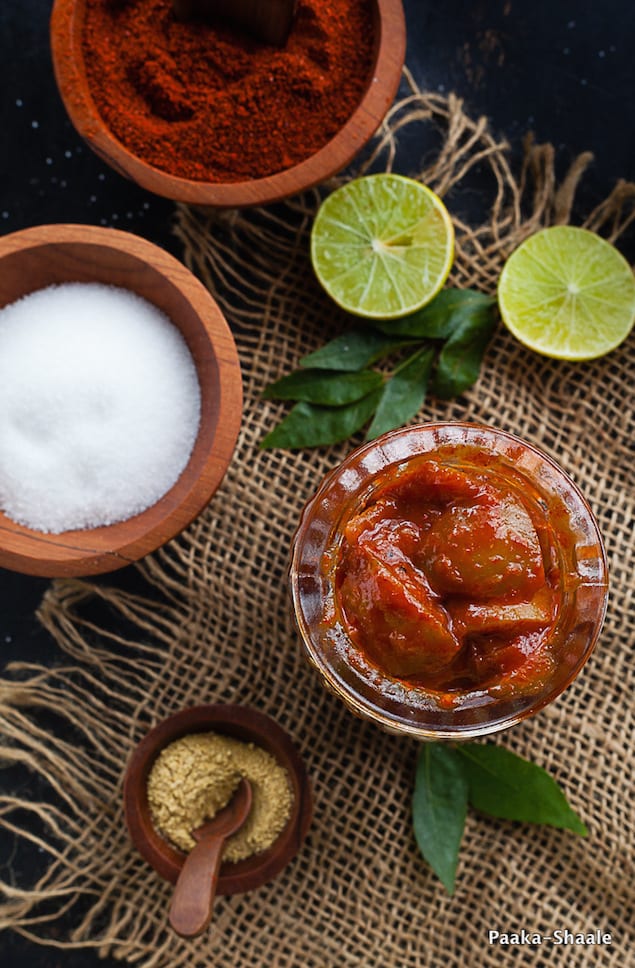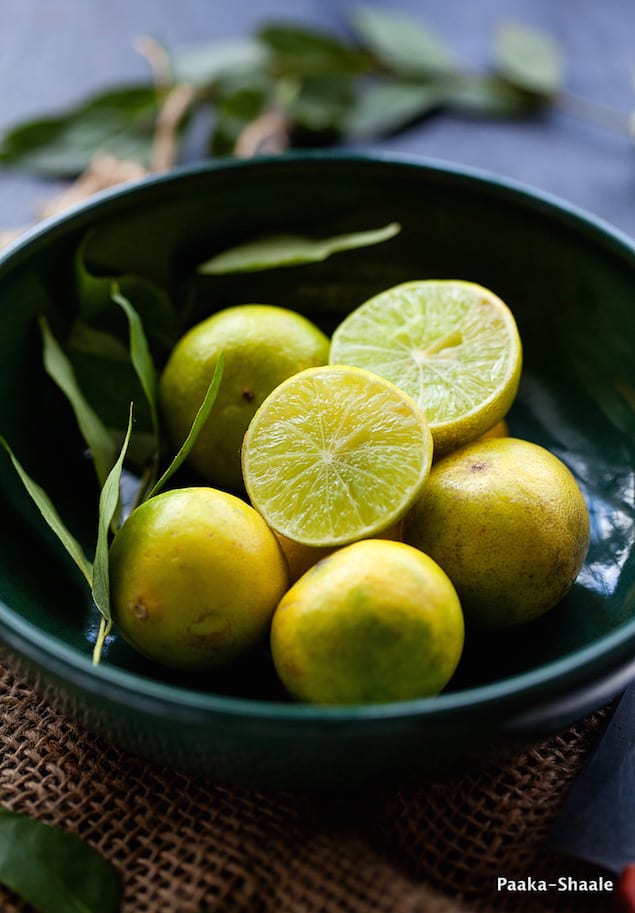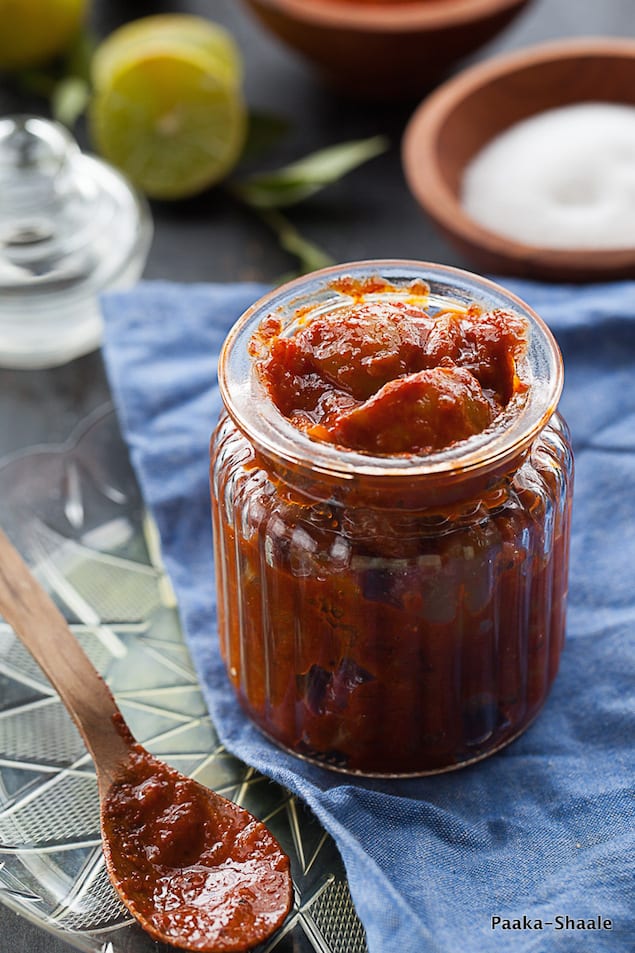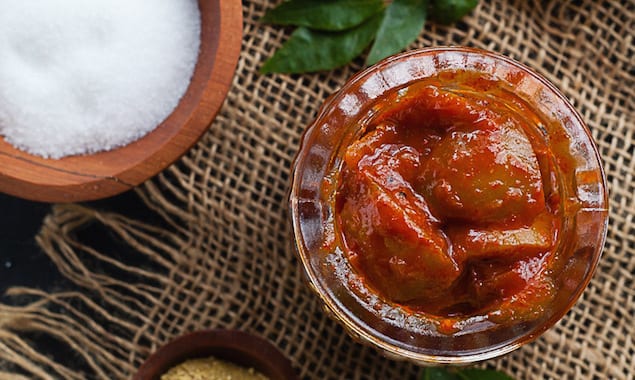These spiced and pickled limes are worth the wait for a finger-licking, fun flavor.
By Nandita Nataraj

The nimbekai uppinakai or the South Indian Lime pickle is a staple in most South Indian houses. Since lime and lemons are available all year long, we were sure to find a big bottle of lime pickle in my Grand parents home. I still remember my grandmother sitting in the tiny portico with an aluminum colander filled with bright yellow lemons. Some times she would be working alone. Sometimes, she would have a neighbor or a friend to accompany her. They would patiently cut and squeeze out the limes and gossip. Her lime pickle would taste slightly different from others because she used to add makali beru or the sarsaparilla root. It is a root that is known for it’s cooling properties. It also gives an astringent taste to the pickle.

I have always believed the process of pickling to be an art. You either get it or you don’t. And I certainly didn’t. At least I thought so, as my first couple of attempts were a huge disaster. It was almost a year back when my good friend Sailaja who is an expert in making pickles and preserves, volunteered to help me. She suggested I try making lime pickles as they are easy to make and quite forgiving. She patiently taught me every step of making the pickle and the final outcome was very encouraging. The pickle turned out finger licking good!!! From then on, there was no looking back.

Indian-Style Pickled Limes
- Yield: about three cups 1x
Description
These spiced and pickled limes are worth the wait for a finger-licking, fun flavor.
Ingredients
- Lime- 35-45 (quantity varies according to the size)
- Iodine free Salt- 1/2 cup
- Kashmiri Red chili powder- 1/4 cup
- Fenugreek seeds- 1/2tsp, Roasted and ground to a fine powder in a mortar and pestle
- Seasoning ingredients
- Groundnut oil- 1/4 cup
- Mustard seeds- 1/2tsp
- Asafetida- 1/4tsp
Instructions
- Wash, wipe and clean the limes with a clean towel and allow it sundry for 30min.
- Cut the lime into eight portions with a clean knife. Deseed them as much as possible. The chopped lemon should measure 3cups or 720ml.
- Extract the juice out of the remaining limes. The juice extracted should measure 3/4the cup.
- Layer the bottom of a clean sterilized Jar with a tea spoon of salt and top it with a layer of cut lime. Continue add the salt and lime pieces in alternating layers till all the lemon pieces are covered with salt.
- Add the extracted lemon juice and cover the jar with a parchment paper or a clean muslin cloth. Secure it tightly with the lid and allow it to stand for 2-3 days in a dry area. Keep shaking the container every 12hrs.
- By the end of the third day, the salt would have dissolved and mixed well with the lime pieces.
- Empty the jar of the preserved lime to a clean bowl. Add the red chili powder, fenugreek seed powder and mix well with a clean wooden spoon. Transfer the pickle back to the jar. Secure the mouth with the parchment paper and the lid and allow it stand for at least 3-4 weeks. By the end of the 4th week, the lime pieces should be very soft. To test if the pickle is done, spoon and piece of lime and try cutting it with your fingers. If the pickle is done, then the lime piece can be cut with minimum force. Also, the pickle should NOT taste bitter.
- Heat the peanut oil in pan and add the mustard seeds. Once they crackle, add the asafetida and turn off the heat. Allow the seasoning to cool completely before adding it to the prepared pickle and mix well. The Pickle is now ready to be relished.
Notes
Make sure all the utensils, jars, ladles and knives are thoroughly washed, wiped and dried.
The bottle that is used for pickling should be washed with hot water and dried in the sun before use. Alternatively, the jar can be microwaved for 30 seconds to ensure complete dryness.
Avoid using your hands to mix the pickle. Unless you want a spoilt pickle.
The quantity of limes will vary depending on the size and the juice content. You could use less than the number of limes mentioned in the ingredients.
The Kashmiri red chili powder gives the pickle and a rich red color without making it too spicy. If you prefer you pickle extra hot, then increase the quantity of the red chili powder by a tbsp.
I have used powdered sea salt. The quantity of the salt may vary if you are using rock salt.
Make sure the seasoning is completely cool before adding it to the pickle. Otherwise, the pickle will develop an odd odor.
- Category: Side, Condiment
- Cuisine: South Indian















Holy cow, this is awesome, so deliicous!
do you mean tsp = teaspoon (very small) or tablespoon (lager quantity)? Due to the large amount of limes teaspoon quantities seem rather small
Hi Amanda, tsp means teaspoon. Happy cooking!
This is a delicious pickle! Worked really well for me. Unlike SOME people, I’m ok with the word lemon appearing, I know what the author means and it did not detract from the finished product. I appreciate the recipe in English so I can make it! Thank you :)
By step 4 the limes have magically turned into lemons
Hi Nandita, can you please advise the approximate weight of limes.
Awesome recipe!